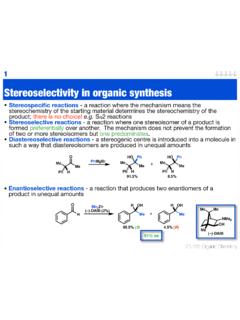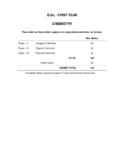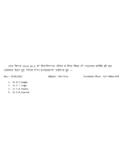Transcription of Two chiral centres (diastereoisomers) - Massey …
1 1. Two chiral centres ( diastereoisomers ). Mirror O O. S R Two enantiomers N. OH HO. N differ by absolute configuration HN NH2 NH2 NH. A molecule with 1 stereogenic centre exists as 2 stereoisomers or enantiomers enantiomers have identical physical properties in an achiral environment A molecule with 2 stereogenic centres can exist as 4 stereoisomers enantiomers (mirror images) still have identical physical properties diastereoisomers (non-mirror images) have different properties O2N O2N. CO2Me CO2Me O O. diastereoisomers trans cis enantiomers epoxide enantiomers epoxide mp = 141 C mp = 98 C. different mp O2N O2N. CO2Me CO2Me O O. Organic Chemistry 2. diastereoisomers NH2 NH2 NH2 NH2 NH2 NH2.
2 diastereoisomers 2 HCl 2 HCl 2 HCl chiral different solubility meso solubility EtOH seperable solubility EtOH. enantiomers differ only by their absolute stereochemistry (R or S etc). diastereoisomers differ by their relative stereochemistry Relative stereochemistry - defines configuration with respect to any other stereogeneic element within the molecule but does NOT differentiate enantiomers In simple systems the two different relative stereochemistries are defined as below: OH OH. Me Me NH2 NH2. syn anti same face different face A molecule can only have one enantiomer but any number of diastereoisomers The different physical properties of diastereoisomers allow us to purify them The differences between diastereoisomers will be the basis for everything we Organic Chemistry 3.
3 diastereoisomers II. OH. CHO. HO. OH OH. (2R,3R,4R)-2,3,4,5-tetrahydroxypentanal ribose OH OH OH OH. CHO CHO CHO CHO. HO HO HO HO four diastereoisomers OH OH OH OH OH OH OH OH. (2R,3R,4R)-ribose (2R,3R,4S)-arabinose (2R,3S,4R)-xylose (2R,3S,4S)-lyxose mirror plane OH OH OH OH. CHO CHO CHO CHO. HO HO HO HO and their 4. enantiomers OH OH OH OH OH OH OH OH. (2S,3S,4S)-ribose (2S,3S,4R)-arabinose (2S,3R,4S)-xylose (2S,3R,4R)-lyxose If a molecule has 3 stereogenic centres then it has potentially 8 stereoisomers (4. diastereoisomers & 4 enantiomers ). If a molecule has n stereogenic centres then it has potentially 2n stereoisomers Problem is, the molecule will never have more than 2n stereoisomers but it might have Organic Chemistry 4.
4 Meso compounds OH. HO2C. CO2H. OH. tartaric acid OH OH OH. HO2C HO2C HO2C. CO2H CO2H CO2H. H. OH OH OH. 2. O. 2H. H. OC. diastereoisomers CH. OO. enantiomers identical H. O. 2C. HC. O2. O. O. OH. OH OH. H. H. CO2H. HO2C HO2C HO2C. CO2H CO2H. OH. OH OH. Tartaric acid has 2 stereogenic centres . But does it have 4 diastereoisomers ? 2 diastereoisomers with different relative stereochemistry 2 mirror images with different relative stereochemistry 1 is an enantiomer The other is identical / same compound Simple rotation shows that the two mirror images are superimposable Organic Chemistry 5. Meso compounds II. Meso compounds - an achiral member of a set of diastereoisomers that also includes at least one chiral member Simplistically - a molecule that contains at least one stereogenic centre but has a plane of symmetry and is thus achiral Meso compounds have a plane of symmetry with (R) configuration on one side and (S) on the other HO2C OH HO OH.
5 HO CO2H HO2C CO2H. rotate LHS. plane of symmetry Another H Cl H H. Cl H Cl Cl chiral achiral no plane of symmetry plane of symmetry non-superimposable superimposable on on mirror image mirror image (but it is symmetric!) (meso). Organic Chemistry 6. chiral derivatising agents Difference in diastereomers allows chiral derivatising agents to resolve enantiomers enantiomerically pure mixture of derivatising agent diastereoisomers R*. R/S R R* + S R*. racemic mixture diastereoisomers separable S R*. R*. R R R*. pure cleave pure enantiomer diastereoisomer diastereoisomer Remember a good chiral derivatising agent should: Be enantiomerically pure (or it is pointless). Coupling reaction of both enantiomers must reach 100% (if you are measuring ee).
6 Coupling conditions should not racemise stereogenic centre enantiomers must contain point of attachment Above list probably influenced depending whether you are measuring %ee or preparatively separating enantiomers Organic Chemistry 7. chiral derivatising agents: Mosher's acid OH F3C OMe DCC, DMAP F3C OMe H. CH2Cl2, 10 C O Me + CO2H. O. N. R/S S C R S & S S. N. DCC - dicyclohexylcarbodiimide Popular derivatising agent for alcohols and amines is -methoxy- - trifluoromethylphenylacetic acid (MTPA) or Mosher's acid Difference in nmr signals between diastereoisomers (above): 1H nmr = (Me)..19F nmr = (CF3). Typical difference in chemical shifts in 1H nmr ppm 19F nmr gives one signal for each diastereoisomer No -hydrogen so configurationally stable diastereoisomers can frequently be separated In many cases use of both enantiomers of MTPA can be used to determine the absolute configuration of a stereocentre (73 JACS512, 73 JOC2143 & 91 JACS4092).
7 Organic Chemistry 8. chiral derivatising agents: salts OTol HO2C. O NH CO2H OTol O NH2. OH OTol O2C. OH CO2H. OTol R/S S diastereoisomer is insoluble so easily removed by filtration NaOH. O NH. OH. ( )-propranolol -blocker No need to covalently attach chiral derivatising group can use diastereoisomeric ionic salts Benefit - normally easier to recover and reuse reagent Use of non-covalent interactions allows other methods of resolving Organic Chemistry 9. Resolution of enantiomers : chiral chromatography Resolution - the separation of enantiomers from either a racemic mixture or enantiomerically enriched mixture chiral chromatography - Normally HPLC or GC. A racemic solution is passed over a chiral stationary phase Compound has rapid and reversible diastereotopic interaction with stationary phase Hopefully, each complex has a different stability allowing separation matched' matched'.
8 Enantiomer - more enantiomer stable (3 interactions) travels slowly mis-matched' mis-matched'. enantiomer - less enantiomer stable (1 interaction) readily eluted racemic mixture chiral stationary in solution phase Organic Chemistry 10. chiral chromatography R/S. inject mixture on to column RS. R O. O O. S chiral column O. Si O. Si O H. O N. prepared from a Si O. O Si Me R suitable chiral stationary phase O. O. Si O. Me Si O. NO2. (many different types). S. NO2. silica chiral amine R chiral stationary phase Measurements of ee by HPLC or GC are quick and accurate ( ). chiral stationary phase may only work for limited types of compounds Columns are expensive (> 1000).
9 Need both enantiomers to set-up an accurate method Organic Chemistry 11. NMR spectroscopy: chiral shift reagents chiral paramagnetic lanthanide complexes can bind reversibly to certain chiral molecules via the metal centre Process faster than nmr timescale and normally observe a downfield shift (higher ppm). Two diastereomeric complexes are formed on coordination; these may have different nmr signals C3F7. O + substrate Eu(hfc)3 substrate O EuL2. Eu(hfc)3. Problems - as complexes are paramagnetic, line broadening is observed (especially on high field machines). Compound must contain Lewis basic lone pair (OH, NH2, C=O, CO2H etc). Accuracy is only 2%. Organic Chemistry 12.
10 chiral shift reagents II. O O. O Sm3+ O CO2H.. O N N O. NH2. H L-valine O Me O. New reagents are being developed all that time that can overcome many of these problems 1H NMR spectra (400 MHz) of valine ( M, [D]/[L] = 1 ) in D2O at pH Organic Chemistry 13. Enzymatic resolution lipase PS from Pseudomonas O cepacia, phosphate buffer, O O. Bu pH 7, NaOH, 5 C Bu Bu + Na OEt OEt O. 60% conversion F F F. R/S R S. >99% ee 69% ee soluble in soluble in organic phase aqueous phase Enzymes are very useful for the resolution of certain compounds Frequently they display very high selectivity There can be limitations due to solubility, normally only one enantiomer exists and can be too substrate specific Below is the rationale for the selectivity observed enzyme H R.
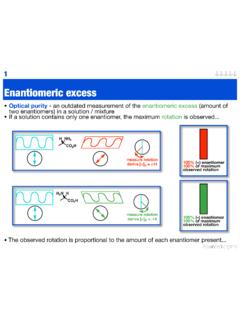
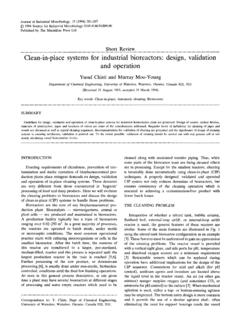
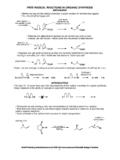

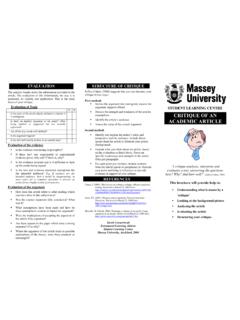
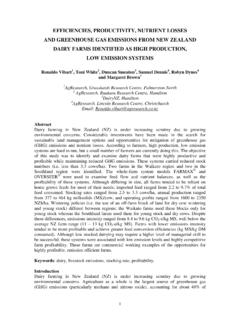
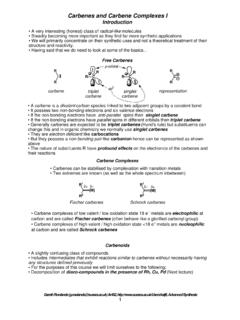
![[3,3]-Sigmatropic rearrangements - Massey University](/cache/preview/0/2/0/3/3/7/7/a/thumb-0203377a43e519e583835c335072f8b8.jpg)
